Ryan Hall's Blog, page 125
September 26, 2017
America’s Greatest Marathoner Prepares For His Final Race
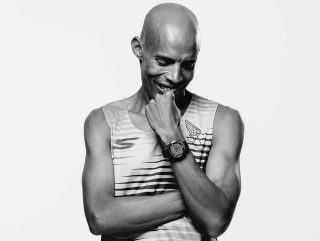

There’s a charming and beautiful symmetry to next month’s New York City Marathon being the final race for heralded American distance runner Meb Keflezighi. It’s his 26th time running 26.2 miles. And the 42-year-old will poetically run his final 42 kilometers where it all began—back in New York where he ran his first marathon in 2002.
When he crosses the finish line, it will bring an end to a remarkable career that spanned two decades at the highest levels of the sport. Along the way, he returned the U.S. to the Olympic marathon podium, set some records and helped heal a wounded city. He remains the only runner in history to win an Olympic medal and victories at the New York and Boston marathons.
It’s rare for a distance runner to permeate the mainstream sports culture. But Keflezighi did, reaching peak popularity with a victory at the 2014 Boston Marathon one year after the horrific bombings.
“I knew that’s when things were going to change,” Keflezighi says. “I knew what that race meant to my country and the people of Boston.”
He was right—everything changed. That’s when he emerged from the obscurity of an often-forgotten sport and was introduced to America as “Meb.”
One Final Race

Keflezighi has no illusions about what he’s facing in New York on Nov. 5. He’s not treating it like a farewell tour. He fully intends to blow past the roses rather than stop to smell them. But he’s also realistic. His body is far different than the one that claimed four NCAA championships at UCLA in the mid ’90s.
“Honestly, I tell people that it’s just another race,” he says. “I’ve accomplished what I wanted to accomplish in my career. But I still have to get to the end. And the sooner I get there, the more pleasant it will be. If I can finish in the top 10, I’ll be happy. If I finish top three, even better.”
Not only will New York bring finality to his career, it will be an opportunity to vent some building pressure. Since his announcement several months ago that it would be his final marathon, the anticipation has been mounting. And for that reason, he’s anxious to just get going.
“Honestly, it can’t come fast enough,” he says. “People know it’s my last one. I want it to be over. They don’t. It’s been a lot of pressure over the last 27 years—a lot of weight on the shoulders internally and externally.
“I’m pretty sure it will be emotional. But my focus is still 26.2 and we’ll see what I can do. It would be nice to win it, but I won’t kid myself. It’s harder than it’s ever been before.”
RELATED: The Top Americans Running This Year’s NYC Marathon
An Unmatched Legacy

Photo: Photorun.net
Any conversation about Keflezighi’s legacy has to begin with Boston in 2014. It was the win the city—and country—needed following the bombings in 2013 that killed three, maimed dozens and injured hundreds more. America was tuning in. And Keflezighi gave the nation something to cheer for.
With the names of the three deceased and a police officer killed by the bombing suspects written on his race bib, Keflezighi mounted an effort for the ages—becoming the first American to tear the tape on Boylston Street since Lisa Larsen Weidenbach (now Rainsberger) in 1985. Greg Meyer was the last man in 1983.
“That was the moment he transcended the sport,” says running historian Ryan Lamppa. “Certainly, his silver medal [in 2004] and his New York victory [in 2009] put him on the map to some degree. But people were paying attention to Boston that year. And when people saw it, it was like ‘Whoa! An American won Boston?’ That’s when people started to know the name Meb.”
With a personal best of 2:08:37—which still remains his fastest 26.2—Keflezighi outsmarted an international field with far superior marathon credentials. But none of that mattered on April 21, 2014—Patriots’ Day.
Keflezighi pushed out hard and fast—building as much as an 80-second lead with less than 9 miles to go. By the time the chase group began to make its move, Keflezighi’s lead was too much to overcome and he held off Wilson Chebet (Kenya, 2:08:48) and Franklin Chepkwony (Kenya, 2:08:50).
“I can take you through every step, but it would take about 2 hours and 8 minutes,” he says with an ear-to-ear grin, adding that “99.9 percent of the time people make that move, they are going to get caught. But I used tactics and positive thinking. Whatever happens, happens. I’m going to go for it. If I get caught, I get caught. But I’m going to make you earn it.”
Keflezighi’s three major achievements—Athens, New York and Boston—all came in milestone fashion. His silver in Athens was the first marathon medal by an American man since Frank Shorter’s silver in 1976. And his 2009 New York win the first from an American since 1982.
“The guy finds a way to rise to the occasion,” Lamppa says. “That’s what great athletes do. Be it Michael Jordan or Wayne Gretzky and the like. His legacy is one of not only great moments, but he also did it in his 20s, 30s and even 40s. That’s a testament to his dedication and his motivation. In totality, I think he’s the greatest American distance runner ever.”
RELATED: Meb’s Thoughts On His Last Boston Marathon
The Next Chapter
Spoiler alert: A year from now, you’re not going to see Keflezighi glued to a couch, 90 pounds heavier and plowing through pints of Haagen-Dazs. Yes, he’s still going to run. More than likely he’ll continue to pace races and half marathons, which he’s done regularly since becoming the Vice President of Running for the Rock ‘n’ Roll Marathon Series in 2014. He might even dabble in coaching.
But charity will always be at the vanguard of his to-do list. His humble and sometimes horrific beginning as an East African refugee are well-documented. The devout Christian recently spent two months in his native country of Eritrea, where he brought his three daughters so they could have a better understanding of their roots.
“You can say it to them,” he says, “but you have to live it to fully understand it. God has a plan for me. I just have to be nice and surround myself with good people, and the rest He will take care of for me. All of the blessings He has given to me. I didn’t plan them. My mom always says a person thinks of it, and God finishes it. And as an immigrant, for me to accomplish what I have, it’s only natural to think about what you can do for others.”
Keflezighi’s immediate plan after New York will be recovery. He’s spoken frequently about the toll a marathon takes on the body. But knowing he doesn’t have to worry about marathon No. 27 is also a blessing unto itself.
He recognizes the career he’s had and the lives he’s touched. That’s an appreciation that will not change in retirement.
“Sports are a beautiful thing,” he says. “It helps you set goals. It helps with time management. It helps with discipline. It helps with self-esteem and a sense of accomplishment. There are so many great things about sports and as much as I can, I want to give back.”
If you know anything about Meb, this shouldn’t surprise you.
RELATED: Read the October 2017 Digital Edition of Competitor Running Magazine

The Best of Meb
Personal records from a remarkable career…
Marathon: 2:08:37/Boston Marathon in 2014/4:54 per mile
Half Marathon: 61:00/Rock ‘n’ Roll Marathon San Jose in 2009/4:42 per mile
10K: 27:13/Stanford Invitational in 2001/4:22 per mile
5K: 13:11/Belgium Track Meet in 2000/4:14 per mile
Meb’s Top 5
Highlight moments according to the man himself…
Winning the Boston Marathon in 2014. “A gold medal at the Olympics wouldn’t have topped that one.”
Winning the New York City Marathon in 2009. “Considering I ran my first marathon there (in 2002) that was a personal gratification for me.”
Winning a silver medal at the 2004 Olympics in Athens. “Most people would put that at the top because it’s the Olympics. But Boston will always be No. 1. It’s probably a wash between winning New York and the medal for No. 2.”
Setting the American record in the 10,000 meters (27:13.98 held from 2001 to 2010; Galen Rupp ran 26:44:36 in 2014). “That will always be a special record for me.”
Winning four NCAA titles while at UCLA. “In my roots, I’m a cross-country runner. Winning that was very special.”
The post America’s Greatest Marathoner Prepares For His Final Race appeared first on Competitor.com.
Doctors Said I’d Never Run Again But I Proved Them Wrong
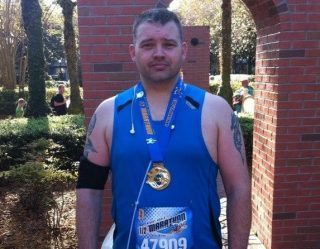 In 2004, my National Guard unit deployed to Iraq. As a motivated 28-year-old infantryman, I was excited to deploy and proud to do my duty to my country.
In 2004, my National Guard unit deployed to Iraq. As a motivated 28-year-old infantryman, I was excited to deploy and proud to do my duty to my country.Conditions in Iraq were horrible. Missions kept us busy most days, and preparations for future missions filled a lot of the rest of our time. Whenever possible, I’d be in the fitness area running or lifting weights with other soldiers.
The weight of my equipment added to the demands of the missions. It led to repeated injury to my legs and knees as I jumped out of trucks to engage the insurgents. I’m not sure if it was due to pride or ego that I didn’t report the injuries, but they went unreported until I got home.
I finally went to the doctor upon my return home. The doctors checked my knees and found a lot of crepitus, which is grinding in the knee. They ordered an MRI and told me I needed surgery.
Following surgery, the doctors told me I would never run again based on the damage they were unable to fix. This crushed me. I was only 29, and I couldn’t run. Walking was also harder post-operation. I became depressed—and frankly, fat—at 298 pounds.
A Major Life Change
In 2010, by sheer luck, I changed units and became a motor transport operator (88M). This change came with my promotion to sergeant. However as soon as my new unit saw how heavy I was, they started to put me out of the Guard. I had to lose weight—and fast. I only knew one way, so I started walking more, despite pain.
A good friend and long-time runner took me under her wing and introduced me to a good pair of shoes. Another friend was there to help motivate me. I progressed from walking to running. I lost 40 pounds in three months, just narrowly passing the test to stay in the service.
As I stood on the start line of my first 5K, I was truly afraid that I wouldn’t finish. Now I start a 10-hour training run, and that memory is among my motivations.
Over the next five years, I lost a total of 100 pounds and have run three half marathons. I began studying physical education at the local college so I can pass on what I have learned and help others.
What I Learned
My advice to runners of all levels—no matter your goal—is this:
Be patient. The best running advice I’ve ever received is to build a strong base mileage and to progress steadily and slowly. If you build that solid base, you will achieve your goals with little injury.
Surround yourself with supportive people. We all have great friends who are a little too competitive for starting out. A friend who motivates you but doesn’t criticize is priceless. And be prepared to be that friend, too.
Let your friends help. Their experience can help you a lot, especially if they are experts like a physical therapist.
Recognize that running is very personal. What works for one runner may not work for you. This is true of shoes, nutrition, training, recovery—every aspect of running. Try everything and see how it fits into your routine. If it’s a fit, great! If not, no worries—just move to the next.
Have fun! Running should be fun. Let’s face it—we spend time outside in great areas, and most races go out of their way to make things unique and challenging.
Today, I am a very happy 208-pound staff sergeant looking forward to running the Badwater 135 in 2018. Every step is a triumph over what I was told. Every race a milestone as I do what makes me happy, healthy and me. I run.
RELATED: Formerly Paralyzed Man Runs Napa Half With Driver Who Hit Him And Doctor
The post Doctors Said I’d Never Run Again But I Proved Them Wrong appeared first on Competitor.com.
China Denies Visa To 101-Year-Old Masters Runner
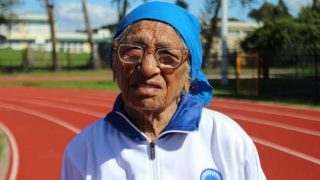
Photo: Stuff.nz
China will not grant a travel visa to 101-year-old runner Man Kaur from India, preventing the athlete from attending the Asian Masters Athlethics Championships. The event started on Sunday in Rugao, China. Kaur had hoped to compete in the 100 meters, 200 meters, shot put and javelin.
Kaur won the 100m gold at the World Masters Games in Auckland in April. Her victory earned her the nickname the “miracle from Chandigarh” in the New Zealand press. She won that race in one minute and 14 seconds, the only athlete in her age category.
Kaur is far from a lifelong runner. She began competing at age 93 when her son, Gurdev Singh, asked her to join him at a meet. Since then, the mother-son pair has traveled around the world, competing at various masters track and field championships. Singh’s visa for the event was also denied.
“We have travelled all over the world, from England to America to New Zealand but never has our visa been rejected,” Singh, a permanent resident of Canada, told international news agency AFP.
Despite not being able to compete, Kaur’s running continues to inspire. She is nominated for a prestigious Laureus World Sports Award in the Best Sporting Moment of the Year category. Voting is open to the general public on mylaureus.com.
Despite the setback, Kaur and her son will continue training in India. Both of them have their sights set on the 2018 World Masters Athletics Championships, taking place in Spain next September.
RELATED: 94 Year-Old Woman Breaks Half-Marathon World Record
The post China Denies Visa To 101-Year-Old Masters Runner appeared first on Competitor.com.
2 Fundamental Injury Prevention Tips From The World’s Best Runners

Staying healthy when you’re putting in the mileage, speed workouts, and long runs to reach your running goals can be daunting.
After all, up to 75 percent of runners will get hurt this year!
That rate of injury makes focusing on prevention a no-brainer. If you can prevent more injuries, you’ll be able to run more consistently, reach higher weekly mileage levels, do more challenging workouts—and ultimately, race a lot faster.
It’s instructive to look at the prevention habits of the world’s best runners. These are athletes often running 100-plus-mile training weeks, completing two training sessions per day, and pushing their bodies to the absolute limit.
What do these runners do differently to stay healthy? How do you prioritize health when you’re training at such a high level?
The lessons we can pull from the training of professional runners can help all of us train more intelligently and prevent future injuries.
Amelia Boone: World’s Toughest
Amelia Boone is a three-time champion of the World’s Toughest Mudder, a Spartan Race World Champion, and arguably the most dominant female obstacle course racer in history. She’s also a full-time attorney for Apple who usually beats 99 percent of men in every race she enters.
Boone focuses on two key areas to stay healthy: mobility and strength. I asked her about preventing injuries and her advice is powerful:
“For runners, single leg strength is everything—I work on single leg stability at least twice a week in the form of lunges, single leg squats, balance work with slant boards, Bosu balls, and other unstable surfaces.
“Dedicate 10 minutes each night before you go to bed to mobilize a particular body part. It doesn’t need to be the same one (and shouldn’t always be the same!), but focus on moving your tissues and loosening up before you go to bed.
“If you are desk bound like I am, do what you can to stay moving as much as possible. Take a lap around the office at least twice an hour. On conference calls, I like to sit in the bottom of a squat or hold a plank. Keep a golf ball at your desk and roll out the bottom of your feet during the day. The little movements add up.”
Boone focuses on daily mobility to stay loose and enhance the recovery process. She also focuses on being strong on each leg individually—an incredibly running-specific way of ensuring she’s strong in just the right way for a runner.
RELATED: 8 Ways To Be Healthier At Work Without Taking A Lunch Run Break
Ian Sharman: Going the Distance
Ian Sharman is a three-time winner of the Leadville Trail 100, a 100-mile race in the Rocky Mountains with an average altitude of over 10,000 feet. He also holds the record for the fastest time in a trail 100-mile race in the United States (12 hours and 44 minutes) and is frequently one of the top ultrarunners in the world.
Like Boone, Sharman focuses on strength and mobility to stay healthy as he competes in some of the most grueling races in the world. His advice:
“I advise a simple routine of dynamic stretches every day, even if you don’t run that day, to improve general strength, flexibility and stability. That includes leg swings, lunges and squats. Even when brushing your teeth balance on one leg to improve core strength and stability. The combination of these and regular foam rolling really help to reduce potential injuries and therefore improve your running.
“A large proportion of non-traumatic running injuries stem from muscle tightness leading to restricted biomechanics and alterations in running gait. Therefore, I advise foam rolling (which is more effective than a massage stick because you can utilize more body weight to apply pressure to the muscles) every day.
“Getting those muscle tissues and the fascia loosened up and able to move freely definitely prevents some easily avoidable injuries.”
So, what can we learn from Boone and Sharman’s advice?
Strength training is critical. Weak muscles are more prone to injury and less resilient to the impact forces of running. Focus on fundamental strength exercises (no gym needed). If you’re not strength training, then you’re not training.
Mobility work works. Mobility—or the ability to effectively move through a full range of motion—is paramount to health. Running causes scar tissue and muscle adhesions to form, which reduce your mobility and negatively impact your stride. Use a foam roller regularly, get a massage if you can, and prioritize those especially tight “trigger points” to stay loose and supple.
These strategies work for the best runners in the world and they should work for you, too!
RELATED: Injury-Proof Your Body With This 10-Minute Strength Routine
The post 2 Fundamental Injury Prevention Tips From The World’s Best Runners appeared first on Competitor.com.
September 25, 2017
Photos From The Rock ‘n’ Roll Montreal Half Marathon & 10K

This past Saturday and Sunday, over 20,000 runners from more than 50 countries took part in four of the five Rock ‘n’ Roll Oasis Montreal Marathon and Half Marathon races (due to the marathon event being canceled because of the heat). A welcome surprise at the start line on the Jacques-Cartier Bridge this year: Montreal Mayor Denis Coderre gave the start of the race in collaboration with Olympic Gold Medalist Bruny Surin. The fact that participants can typically choose among five distances, the full and half marathons, 10K, 5K and 1K, in addition to a great selection of bands along the course explains the popularity of the event, which concluded its 27th edition this afternoon. This was also the year of newness, with a new course for the 5K race on Saturday, medal designs that were voted for by event fans themselves earlier this year, and the chance for runners to take part in the Rock ‘n’ Roll Marathon Series’ Remix Challenge and earn exclusive medals for their collection. Daniel Gekara, from Kenya, was first to cross the finish line in one hour, 7 minutes and 56 seconds (1:07:56). The first woman to complete de 21.1 km race was Dehinet Jara, from Ethiopia, with a time of one hour and seventeen minutes (1:17:43).
Photos: Kevin Morris/PhotoRun.net
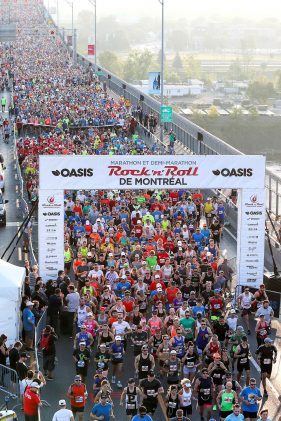




























The post Photos From The Rock ‘n’ Roll Montreal Half Marathon & 10K appeared first on Competitor.com.
Book Your Flight! Tips For Running Your First International Marathon
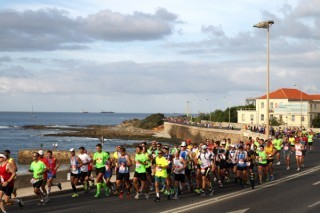
Since I started running six years ago, my race goals have become less about pace and personal bests. Instead it has become more about the experience of the race. I hardly run the same race twice, because with so many events in so many incredible locations, why repeat myself? For years, I’ve wanted to do an international marathon. My wallet, however, had other ideas and begged me to stay within driving distance.
Then a last minute gift graced my inbox—an all-expenses paid trip to run and cover the Jerusalem Marathon in March of 2015. I said “Yes!” But immediately I began to wonder how running internationally would differ from running in the U.S. Sure, the details and logistics would depend on the host country, but what might be some overall contrasts? Moreover, how would I pack and prepare for a race that was nearly 7,000 miles away?
Now that the Jerusalem Marathon has come and gone and I am back at my desk in Colorado, here are my best tips for preparing for and running your first race abroad. (Yes, one international race makes me a pro.) I’ll also include some differences that I observed between racing stateside and in a foreign country.
Race Prep
Don’t expect an international marathon to be a PR race. You are likely to use the race as a day of sightseeing. Bring your camera along and meet people on the course from different countries. It is all part of the experience. I wore a SPIbelt to carry my camera and gels.
Although you might be anal about your pre-race eating rituals, be prepared to relax a bit. You are in a foreign country that has new and exciting foods. While you might not want to sample the spiciest and richest dishes available, don’t overly deprive yourself.
Keep drinking water. By nature, traveling dehydrates you. Make a special effort to carry water with you and keep guzzling. Check online for information about the safety of drinking the tap water in the country you are visiting.
On the flight over and back, get up and stretch as much as you can. Wear compression socks to keep your blood flowing. Traveling can sometimes cause major constipation (or the opposite!). Bring along your Tums, Maalox or whatever gets you through this type of thing.
Finally, do your research. Most marathons have websites showing elevation profiles, average temperatures, aid stations and other details. If you don’t want to experiment with what is available at “foreign” aid stations, bring your own fuel and hydration.
RELATED: A Look At Aid Stations Around the World
Some Differences to Keep in Mind
Your race outfit might be a bit different from others. In Jerusalem, for example, I was the only person I saw in a running skirt. Most women wore tights or shorts. Men wore very short shorts. There were few of the knee length, basketball style ones we see in the states. There were only a handful of women running in sports bras with no shirts. They were continually gawked at.
Do your research to find out what is available at the aid stations. In Jerusalem, the description of the aid stations boasted “isotonic” drink and gels. I did some research and found out “isotonic” was basically another way of describing an electrolyte drink. At the expo, I found out the gel on the course would be GU. What I did not anticipate were aid stations with hummus, raw veggies, pickles and coffee urns.
Another difference was the popularity of the race shirt. Nearly half of the runners wore their race shirts during the marathon. I have not found this to be true in the U.S. The website for the marathon encouraged runners to do this to promote unity amongst the athletes.
Porta-potties were in short supply. People at the start were finding bushes and even squatting right on the road. Along the route, there were signs pointing to public restrooms.
And what about mile markers? Well, there were none because they were all in kilometers! This should have been obvious, but was something that didn’t register with me until I was on the course. I was glad I had my Garmin to keep track of actual miles because my brain cannot do math while I run.
While I’ve highlighted some of the differences here, the overall experience did not feel at all foreign, and there were certainly more similarities than contrasts. Running is an incredible unifier of people regardless of age, ethnicity, culture, gender or race. We all feel fatigue, joy, thirst, frustration and triumph. And in the end, we all travel the same route and get the race done.
RELATED: 10 Fall Races That You Can Still Register For
The post Book Your Flight! Tips For Running Your First International Marathon appeared first on Competitor.com.
Warsaw Marathon Under Fire After Failing To Help Collapsed Runner
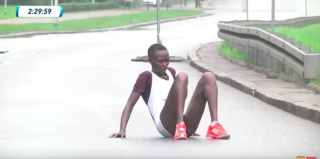
The organizers of the Warsaw Marathon are under fire after officials failed to help Kenyan Recho Kosgei after she collapsed 800 meters from the finish line.
Kosgei had nearly a three minute lead on the next competitor as she made her way towards the marathon finish. With only a half mile to go, she suddenly veered towards the side of the road and fell. Kosgei spent over two minutes struggling to stand up without any race officials, spectators or runners coming to her aid. Finally a runner in the men’s race, Marek Hladik of Slovakia, attempted to lift her off the road.
While Hladik attempted to help Kosgei, Ethiopian Bekelu Beji passed both of them, winning the race in 2:35:08. Kosgei received treatment by medical personnel for dehydration and did not complete the marathon. Hladik went on to finish 10th in the men’s race.
Many have taken to social media to criticize the marathon’s failure to help. Fellow Kenyan and 2012 Boston Marathon winner Wesley Korir tweeted that, “Although it’s illegal for race official to help a runner I think there comes a time when logic takes over.”
This beyond acceptable Although it’s illegal for race official to help a runner I think there comes a time when logic takes over @iaaforg https://t.co/h6J0NEk7eF
— Hon wesley korir (@weskorir) September 25, 2017
Journalist Saddique Shaban said that leaving Kosgei to struggle was “unacceptable negligence on the part of the organizers.” He continued that “Cases of athletes dying in road races, mostly amateurs, have been on a rise. But this was no amateur athlete.”
This video need to go viral. Unacceptable negligence on the part of the organizers. https://t.co/N1BjhYflz5
— Saddique Shaban (@SaddiqueShaban) September 25, 2017
The Warsaw Marathon has yet to release a statement regarding the incident.
RELATED: Determined Marathoner Rolls Across Finish Line After Collapsing
The post Warsaw Marathon Under Fire After Failing To Help Collapsed Runner appeared first on Competitor.com.
Charmin Offers “Mad Pooper” A Year’s Worth Of Toilet Paper

Much like the whereabouts of D.B. Cooper, Tupac and the ending of “The Sopranos,” the identity of the “mad pooper” still remains a mystery.
Last week we brought you the story of the Colorado Springs, Colo., woman who, for reasons still unknown, continues to terrorize the Budde family by stopping on her runs to poop on their lawn. Consider this an update—or story No. 2.
A video about the mystery pooper appeared on YouTube over the weekend, in which a man claiming to be a “spokesperson” for the woman said she will remain anonymous. He added an apology, saying the woman had issues following a “TBI” (traumatic brain injury) which has led to mental instability and a lack of bowel control.
The validity of the video could not immediately be verified, though at least one Denver television reporter tweeted out the video.
A spokesman for the Colorado Springs Police Department said last week that while the viral story has humorous undertones, they are being sensitive to the fact that mental health could play a role.
According to the Budde family, in the original report, the woman has used their lawn at least seven weeks in a row despite public restrooms being available less than a block away.
Eager to squeeze out some publicity, at least two bathroom-centric companies have reached out to the mad pooper by way of social media, urging the woman to turn herself in.
Last week, toilet paper powerhouse Charmin offered the woman a year’s supply of toilet paper “to help with her ‘runs’” if she turned herself in.

Squatty Potty (you might know this company from its viral ads of unicorns doing their business in rainbow form), tweeted that their product could help the mystery woman with her problems.
Dear #MadPooper, all you need is a @squattypotty. #Problemsolved #squattypotty pic.twitter.com/uIEbM95sir
— Squatty Potty® (@squattypotty) September 21, 2017
The story went viral last week after it was reported by local CBS affiliate KKTV in Colorado. And of course, the internet loves to dig into some sh… stuff like this. Twitter was ablaze with new nicknames for the woman … such as the Femme Fecale and Charmin San Diego.
The woman could face charges of indecent exposure and public defecation.
RELATED: Mystery Runner Won’t Stop Publicly Pooping Around Colorado Town
The post Charmin Offers “Mad Pooper” A Year’s Worth Of Toilet Paper appeared first on Competitor.com.
September 24, 2017
Formerly Paralyzed Man Runs Napa Half With Driver Who Hit Him And Doctor
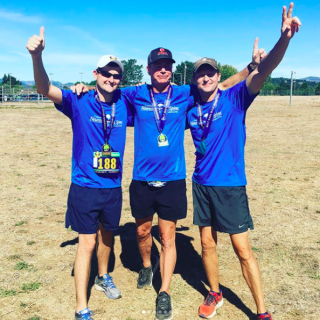

Photo: instagram.com/clairehossimmons
Sunday’s Napa Half was a big moment for Dean Otto, who one year ago was in the hospital suffering from temporary paralysis after being hit by a truck while cycling.
This weekend, he was joined by that same truck driver and the doctor who helped him recover out on the Napa Half Marathon course.
RELATED: This Paralyzed Athlete Is Out To Prove He Can Compete Again
According to the Napa Valley Register, Otto was on a bike ride in 2016 when he was accidentally hit from behind by 27-year-old Will Huffman in North Carolina; Huffman immediately tried to render aid but Otto knew his injuries were serious and knew to stay still.
“Doctors determined he had minimal sensory function below the waist and a CT scan revealed that his spinal column was crushed inward,” the paper reports. “He also had a broken pelvis, a broken tailbone, a broken leg and several broken ribs.”
Matthew McGirt, MD, a neurosurgeon, performed surgery and just one day after recovery, Otto made a bet: If he could wiggle his big toe, Dr. McGirt would have to run a half marathon alongside him. Otto obviously won that bet.
He knew that learning to walk again would be a battle and wanting to heal emotionally, as well, he met with Huffman and forgave him.
“He was there by my side – there to aid me,” Otto said of Huffman. “He didn’t run off and hide. He did the honorable thing.”
As they formed a friendship, Huffman decided to join Otto and McGirt in their race and they chose the Napa Half Marathon for its date one year after the accident.
RELATED: Paralyzed Woman Makes Marathon History
People have been so inspired by Otto’s story and the mens’ journey to a half marathon that they even were guests on Ellen and will soon be featured on The Today Show.
The trio finished the race in just under two hours and can be seen finishing side-by-side-by-side in a video shared on Facebook.
The post Formerly Paralyzed Man Runs Napa Half With Driver Who Hit Him And Doctor appeared first on Competitor.com.
Kipchoge Wins But No World Record At 2017 Berlin Marathon
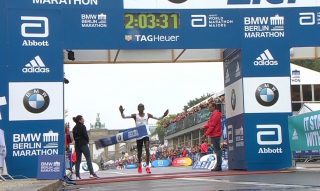
A world record didn’t fall this morning at the Berlin Marathon. However Eliud Kipchoge of Kenya and Guy Adola of Ethiopia kept the race exciting, battling back and forth until the very end. It was the veteran Kipchoge who finished first in 2:03:32, 35 seconds off of Dennis Kimmetto’s world record of 2:02:57, set at the 2014 Berlin Marathon. It was the 6th fastest time ever run in Berlin. Adola, in his first marathon, finished second in 2:03:46, the quickest debut time ever. Felix Kandie was a distant third in 2:06:12.
Two of the favorites to chase the world record did not factor into the race. Kenya’s Wilson Kipsang, who finished second last year, dropped out of the race at 30K. Last year’s champion, Kenenisa Bekele of Ethiopia, left the course soon after. This left Kipchoge and Adola running shoulder to shoulder for much of the end of the race. Adola threw in surges around 37K but Kipchoge took the lead at 40K and never looked back. The rainy and humid weather kept both runners slightly off world record pace.
The last two years have been filled with breakout performances from Kipchoge. In 2016, he won the London Marathon and the Rio Olympic Marathon. In May, he ran a spectacular 2:00:25 at Nike’s Breaking2 event, although that time did not count as a world record due to the controlled conditions.
A speedy 10,000-meter and half marathoner, 26-year-old Adola could now be a new force in the marathon distance. Although he had to settle for second, Adola’s marathon debut is now the 8th fastest Berlin Marathon time ever ran.
In the women’s race, Gladys Cherono of Kenya surged ahead of the pack to finish in 2:20:21, winning her second Berlin Marathon. Ruti Aga of Ethiopia was second in 2:20:41 and Valary Aiyabei of Kenya is third with 2:20:53.
The next World Marathon Major on the calendar is the Chicago Marathon, taking place on October 8.
The post Kipchoge Wins But No World Record At 2017 Berlin Marathon appeared first on Competitor.com.
Ryan Hall's Blog
- Ryan Hall's profile
- 21 followers



